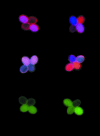Meiosis in living color: fluorescence-based tetrad analysis in Arabidopsis
- PMID: 17360410
- PMCID: PMC1820640
- DOI: 10.1073/pnas.0700276104
Meiosis in living color: fluorescence-based tetrad analysis in Arabidopsis
Conflict of interest statement
The author declares no conflict of interest.
Figures

Comment on
-
Pollen tetrad-based visual assay for meiotic recombination in Arabidopsis.Proc Natl Acad Sci U S A. 2007 Mar 6;104(10):3913-8. doi: 10.1073/pnas.0608936104. Epub 2007 Feb 23. Proc Natl Acad Sci U S A. 2007. PMID: 17360452 Free PMC article.
References
-
- Weinstein A. Proc Sixth Intl Congress Genet. 1932;2:206–208.
-
- Hawley RS, Walker MY. Advanced Genetic Analysis. Malden, MA: Blackwell; 2003.
Publication types
MeSH terms
Substances
LinkOut - more resources
Full Text Sources

